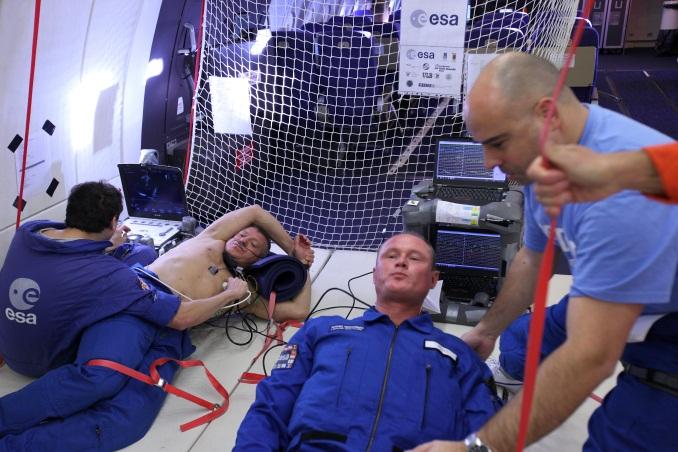B3D
Ballistocardiography (BCG) is a non-invasive technique for assessing the cardiac function from the body accelerations consecutive to the mechanical action of the heart (contraction, ejection of blood, etc…). The technique was nearly abandoned in the 1970’s. On Earth, it was typically based on the recording of horizontal 2D accelerations or movements of subjects in supine position at rest on a freely-moving platform. In this position the ventro-dorsal component is directed vertically and subject to the influence of gravity. Space is the only place where Ballistocardiograms can be recorded (unaltered) in 3-Dimensions.

The Spacelab-D2 mission allowed such recording of 3D Ballistocardiogram in a free floating astronaut. For the analysis of this unique data set we developed novel signal processing technique showing that the full potential of this technique had not been exploited yet.
This method for the analysis of vecto-ballistocardiograms is at the heart of our proposal to further study Ballistocardiography in microgravity.

To further validate and refine the diagnostic value of this technique, we will perform 3D-BCG recordings together with other standard and well recognized techniques in sustained micrgravity on board the International Space Station. The proof of concept is currently evaluated in transient microgravity obtained in ESA parabolic flights campaigns. During these, our subjects are equipped with non-invasive wearable cardiac monitoring systems. Since 2011 we have been testing the Pneumocard-Ballisto system developed by the MKS company. The subjects alternate between three different protocols: a traditional Echocardiography cardiac function evaluation; a free-floating experiment during which 3D-BCG, ECG, Impedance-cardiography and respiration signals are recorded; a full rotation of the subject facing a stereo acquisition setup for the determination of its centre of mass.
The proposal entitled: 3-D Ballistocardiography in microgravity (B3D), submitted to the ESA ILSRA-2009 AO was selected by ESA and the European Science Foundation (ESF) to enter its definition phase.
This project is the result of an international collaboration with the following teams:
- University of California San Diego (UCSD), Departments of Medicine and Radiology, San Diego, USA
- Russian academy of sciences, Institute of Biomedical Problems (IMBP), Laboratory for autonomic regulation of cardiorespiratory system, Moscow, Russian Federation
- Medizinische Hochschule Hannover, Institut fur Klinische Pharmakologie, Hannover, Germany
- Fondazione Don Carlo Gnocchi Onlus, Polo Tecnologico, IRCCS “S.Maria Nascente”, Milano, Italy
- Politecnico di Milano, Neuroengineering and medical robotics Laboratory (NEARLAB), Milano, Italy
- Université Libre de Bruxelles, Hypertension Clinic, Dept. of Cardiology, Erasme Hospital, Belgium
- Vrije Universiteit Brussel, Dept of Experimental and Applied Psychology (BIPS), Brussels, Belgium
The study is sponsored by the European Space Agency, the National Space Biomedical Research Institute and the Belgian Science Policy.

|

|

|
